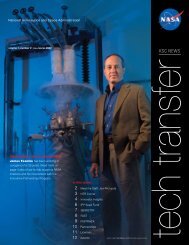2006-2007 - Kennedy Space Center Technology Transfer Office
2006-2007 - Kennedy Space Center Technology Transfer Office
2006-2007 - Kennedy Space Center Technology Transfer Office
- No tags were found...
Create successful ePaper yourself
Turn your PDF publications into a flip-book with our unique Google optimized e-Paper software.
Distributed Observer NetworkNASA’s advanced visual simulations are essential for analyses associated with life cycleTask/ProcessModeling and planning, design, training, testing, operations, and evaluation. <strong>Kennedy</strong> <strong>Space</strong> <strong>Center</strong>, inSimulation particular, uses simulations for ground services and space exploration planning in an effortto reduce risk and costs while improving safety and performance. However, it has beendifficult to circulate and share the results of simulation tools among the field centers, and distanceand travel expenses have made timely collaboration even harder.In response, NASA joined with Valador Inc. to develop the Distributed Observer Network (DON), acollaborative environment that leverages game technology to bring 3-D simulations to conventionaldesktop and laptop computers. DON enables teams of engineers working on design and operationsto view and collaborate on 3-D representations of data generated by authoritative tools, such asDelmia Envision, Pro/ENGINEER, or Maya. DON takes models and telemetry from these sourcesand, using commercial game engine technology, displays the simulation results in a 3-D visualenvironment. Multiple widely dispersed users, working individually or in groups, can view andanalyze simulation results on desktop and laptop computers in real time.The development team experimented with a variety of NASA mission segment simulations, includingSynergistic Engineering Environment (SEE) data, NASA Enterprise Visualization Analysis (NEVA)ground processing simulations, the Dynamic Simulation Suite (DSS) simulation for lunar operations,and the Johnson <strong>Space</strong> <strong>Center</strong> TRICK tool for guidance, navigation, and control analysis.Users connect to DON through a client that runs on their own PCs or Mac computers. They canmove freely within its virtual world and can preset camera points that let them jump to specificviews. DON allows users to communicate textually or via Voice over Internet Protocol (VoIP); towrite and save notes; and to replay, forward, fast-forward, pause, and loop simulations. ThroughDON, team members can share data, coordinate their work efficiently, and create a digital repositoryof their simulations and related information.DON is slated for a 2008 release to support simulations for the Constellation Program. Plans forfurther development include improving DON’s interaction with existing systems. Beyond NASAapplications, DON offers opportunities in education and a myriad of other industries, particularlyfor overcoming the challenges that face dispersed teams collaborating on complex problems.Contacts: William L. Little , NASA-KSC, (321) 861-8938; and Rick Brubaker,Valador Inc., (703) 435-9155Participating Organizations: NASA-KSC (Michael P. Conroy and Rebecca A. Mazzone), ASRC Aerospace(Dr. David K. Mann, Phillip B. Michael, and Michelle S. Ruder), and Valador Inc. (Tom Cuddy and Fred Spiker)96 Process and Human Factors Engineering Technologies













